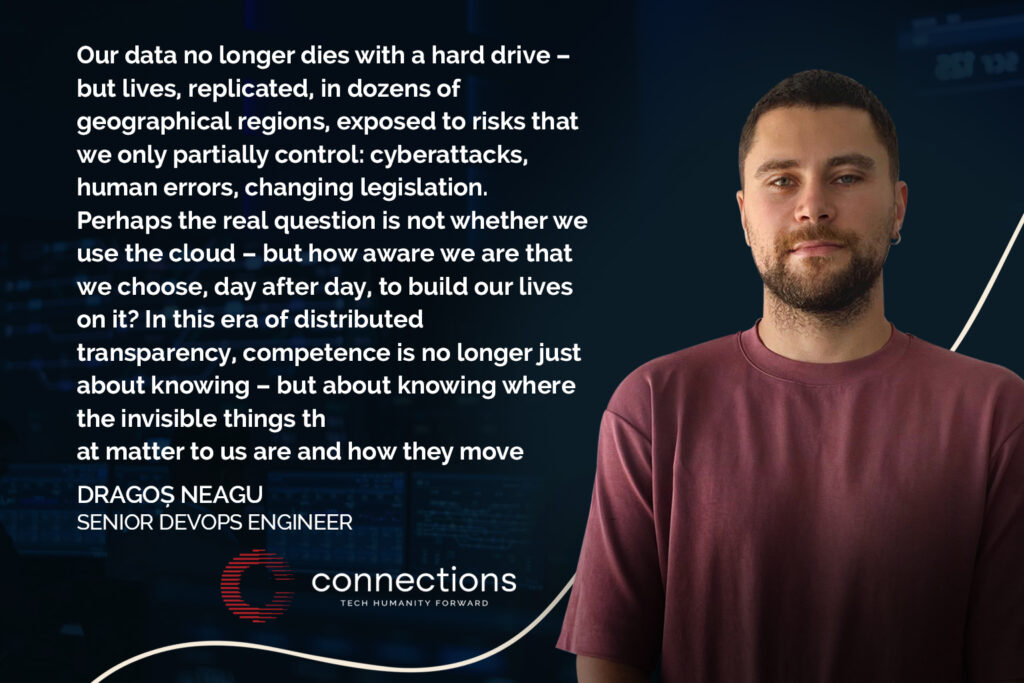
Few technologies have penetrated our lives as deeply, silently, and irreversibly as the cloud. It didn’t ask for our permission, but it didn’t force its way in either. It was there—available, discreet, in the shadows of our daily lives—as our habits transformed and the world’s infrastructure became increasingly virtual.
For a long time, cloud computing was seen as technical jargon reserved for IT specialists, a footnote in digitalization strategies. In reality, it is the backbone of a global economy in rapid transition—from physical to digital, from centralized to distributed, from ownership to access.
PROFESSIONAL: we work from inside a network, not just from an office
In the professional environment, the cloud has rewritten the rules of the game. A software development company in Romania can have a testing team in Serbia, with data synchronized in real time. A fintech startup launches an application in a few months, using an “as-a-service” infrastructure that scales automatically. A retail chain monitors its inventory in real time, with automatic alerts and replenishment suggestions based on algorithms hosted in the cloud.
Doctors in different hospitals can see the same file. Architects in different cities can model a building in real time. Startups can launch scalable products in a few months. Retailers can track inventory and receive automatic suggestions, in real time.
The cloud means mobility, continuity, adaptability. Work becomes independent of space, and ideas are no longer lost with a device. We can work from the train, we keep photos and files without fear of loss, and memories become accessible, anytime, anywhere.
It is an infrastructure that connects individual effort to a global network. It redefines our perception of time, space, collaboration. We no longer work from offices – but from a network. We no longer archive physically – but digitally, distributed, securely.
The cloud connects individual effort to a global infrastructure. And this connection redefines our perception of time, space, and collaboration. We no longer work just from an office – we work from a network.
HOME: digital memory, new reflexes, freedom of movement
Whether we are editing a document with a colleague from another part of the country, or relaxing on the couch with an episode of Netflix in the evening, we call on the cloud infrastructure without realizing it. It is there when the phone automatically backs up to iCloud or Google Photos. When we say “OK Google, play tonight’s playlist” or when we find, in a few seconds, a photo from 2016 in Amazon Photos or OneDrive.
The cloud synchronizes WhatsApp conversations between the phone and the laptop. It optimizes the route in Waze, based on data collected and processed in real time. It is present in Spotify, in the e-banking application, in all those trivial interactions that define a fluid digital life today.
At home, in our personal lives, the cloud is the silent archivist of our digital memory. It synchronizes our calendars, saves notes, plays back memories. Automatic photo backup, instant document sharing, saving Notion’s diary to the cloud – these are everyday reflexes that have become natural.
And even if we don’t work in tech, the cloud is essential. It allows doctors to access patients’ medical histories from any hospital. It gives architects the ability to collaborate on the same 3D building from four different cities. Or a project manager the freedom to adjust a timeline directly from their phone, at the airport.
Behind this simplicity, however, lies one of the most sophisticated technological constructions of the present – a constantly expanding ecosystem, where innovation, security, regulations and the real needs of users converge.
The cloud is not just a technical solution. It is a cultural choice. Accepting it requires trust: in suppliers, in cryptography, in redundancy. And a paradigm shift: we no longer keep information locally, but disperse it in a controlled manner. We no longer work with technology, but through it.
As important, present and necessary as the cloud is in our daily lives, Dragoș Neagu, Senior DevOps Engineer at Connections, reminds us that with this freedom comes a new form of fragility: “Our data no longer dies with a hard drive – but lives, replicated, in dozens of geographical regions, exposed to risks that we only partially control: cyberattacks, human errors, changing legislation. Perhaps the real question is not whether we use the cloud – but how aware we are that we choose, day after day, to build our lives on it? In this era of distributed transparency, competence is no longer just about knowing – but about knowing where the invisible things that matter to us are and how they move around.”
